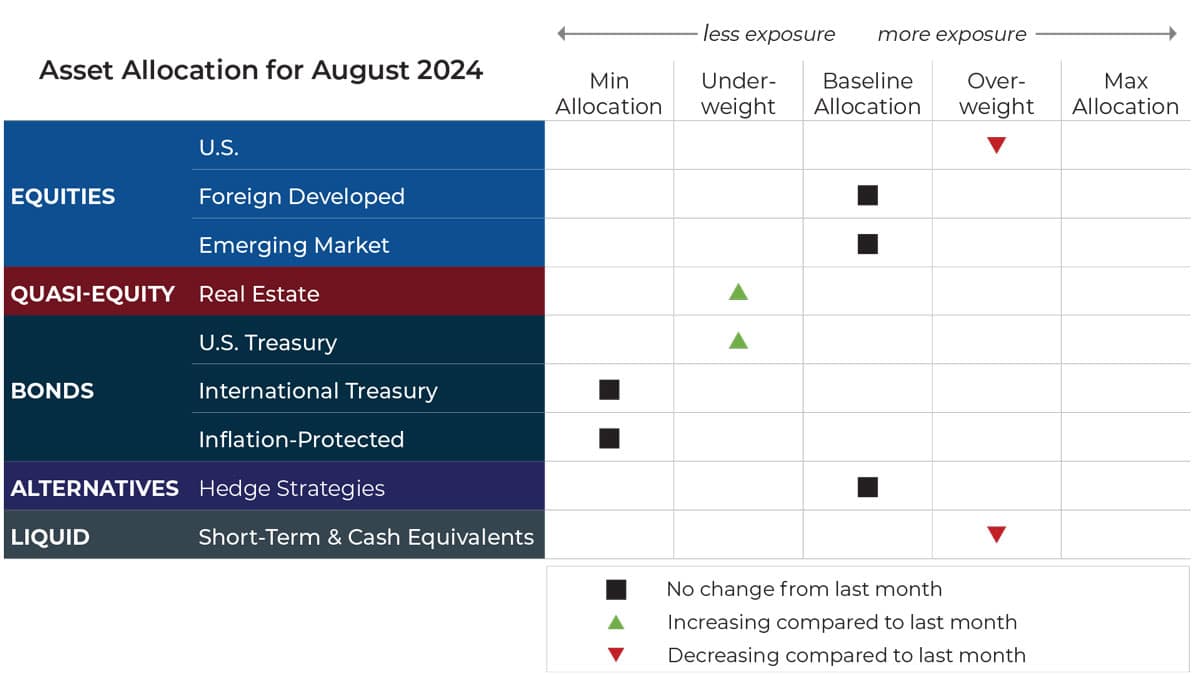While Market’s Direction is Uncertain, Our Response is Predetermined
“We don’t see things as they are, we see them as we are.” –Anaïs Nin
In investing, behavioral biases often amplify investor anxiety. Periods when steady gains are followed by modest declines can be particularly unnerving. This reaction is rooted in behavioral economic principles, such as loss aversion and recency bias, where the fear of losses and recent market performance disproportionately impact decision-making. At Spartan, we aim to mitigate these biases through a systematic investment process rooted in trend following.
In our view, trend following helps us provide disciplined action for clients’ portfolios during varied market environments. This would include minor market corrections, which we define as a “stage 1” or “reversion to the mean” decline when we talk about the anatomy of a bear market. This stage represents a natural and expected part of market behavior, where prices tend to adjust after a significant run-up. Despite the discomfort a “stage 1” decline might cause, they generally should not prompt immediate concern or reactive decision-making. Instead, our disciplined trend-following strategy often ensures that we stay invested, avoiding the pitfalls of emotional responses or prematurely being “bounced out” of a trend.
Our risk management approach focuses on maintaining a consistent yet adaptable plan, allowing us to manage both market highs and lows. By adhering to a systematic process, we seek to navigate market outliers and maintain long-term compounding, even in the face of short-term volatility.
In this month’s Note, we explore the impact of behavioral biases on investment decisions, as well as how our trend-following strategy can help mitigate these effects. We also discuss recent market events, how they fit into the context of the anatomy of a bear market, and our continued focus on preserving compounding through disciplined risk management.
But first, here’s a summary of our take on what transpired in the markets heading from July to August.

Disclaimer: This note is for general update purposes related to the general strategy and approach of Spartan Planning portfolios. Every client’s situation including Risk Profile, Time Horizon, Contributions, and Distributions is different from other clients. Your exposure to any given asset class will depend on your goals, risk profile, and how tactical or static your risk profile calls for. Adjustments can vary across strategies depending on each strategy’s objectives. What’s illustrated above most clearly reflects allocation adjustments for the Growth Strategy. If there have been changes to your risk profile and/or goals or if you wish to discuss them in more depth, please contact your advisor.
ASSET-LEVEL OVERVIEW
Equities & Real Estate
With a mid-month pullback that began July 17, the S&P 500 Index was on the verge of only its second negative month in 2024. In last month’s Note, we highlighted disparities between major segments of the equity markets. As if on cue, markets reversed course with laggards — such as value, high dividend, and mid and small caps — becoming leaders. Meanwhile, tech and growth dropped to the back of the pack. Regardless of the role reversal, all segments remain in uptrends. As a result, our portfolios will remain overweight U.S. equities, particularly large- and mega-cap stocks.
Foreign developed and emerging markets allocations remained steady heading into August. Emerging markets remain just ahead of their developed-market counterparts for the year, but both continue to be weaker relative to U.S. equities.
Real estate securities were on pace to be the best-performing asset class in July, among those we track closely. The increase is also enough to push it into positive territory for the year at the moment. Perhaps more importantly, the rise in prices has created uptrends across all timeframes we monitor. The result is an increase in exposure in our portfolios. With that said, a cap remains on exposure due to the long-term weakness compared to the U.S.
Fixed Income
Like equities, bonds had also generally risen in July. However, performance has been, at least for the moment, varied among the different segments of the yield curve. While all points on the yield curve that we monitor are positive, when controlling for the historical volatility of the instrument in question, shorter-duration bonds have been the best performers. Assessments of trends are also varied: short- and intermediate-term Treasuries are now in uptrends for all timeframes, but longer-duration bonds remain mixed, with the long-term trends still negative.
Sourcing for this section: Barchart.com, S&P 500 Index ($SPX), 7/1/2024 to 7/29/20244
Three potential catalysts for trend changes:
-
Labor Market Cooling: The unemployment rate increased to 4.1% in June, marking the first time it has crossed higher than 4% since 2021. While low by historical accounts, it is up from 3.4% early last year. Workers have stopped quitting jobs at a frenetic pace, and college graduates are having a challenging time breaking into the job market. The number of open positions for every unemployed person is back to the pre-pandemic level of 1.2, which is down from more than 2.0 in 2022. The hiring rate has also fallen back to its pre-COVID level.
-
Juggling Act: With inflation still above target and the labor market cooling, Fed officials are facing a conundrum about which problem they need to address. The Fed does not expect demand or hiring to weaken in the coming months, but if wrong, the Fed will not be able to cut rates quickly enough to forestall a recession.
-
Home Prices Still Up: For the second month, home prices hit a new high in June. The low inventory of homes for sale in much of the country is pushing prices higher. The national median existing-home price in June rose to $426,900, another record in data going back to 1999 and a 4.1% increase from a year prior.
Sourcing for this section: The Wall Street Journal, “The Hottest Job Market in a Generation Is Over,” 7/24/2024; and The Wall Street Journal, “U.S. Home Prices Hit Record in June for Second Consecutive Month,” 7/23/2024
Context Is Key
“For me, context is the key – from that comes the understanding of everything.” – Kenneth Noland
Two years ago we went to some effort to build a mental model for understanding what we see as the different stages of market declines. We believed then, as we do now, that having a proper framework for judging markets is an important behavioral element to managing emotional responses to varying markets. We think of that model as the anatomy of a bear market. The basic premise is that not all market declines are equal; while some should be monitored very closely, others are better left ignored. Context is the key to determining which is which, and how one should respond. We believe the discipline of trend following is uniquely suited to provide context, as well as guidance on the correct response to navigate through the various stages of market declines.
We believe current equity markets are providing a real-time illustration of this mental framework. Judging from some reactions we’ve observed among individual investors heading into August, one might believe markets are on the cusp of impending doom if not already experiencing it. Looking back to the previous quarter in 2024 gives us another example of putting this framework to use and observing how reality played out.
Back in April, the S&P 500 Index fell almost 6% from its intra-day peak on March 28 to its intra-day trough on April 19. At no point did trends of any meaningful duration even flirt with flipping from positive to negative. Consequently, our allocations never changed. Within 30 days, on May 15, the index had erased the deficit and made new all-time highs once again. The April decline was a perfect example of what we call a “stage 1” or “reversion to the mean” style decline. In our opinion, stage 1 declines are healthy retracements that should generally be ignored. In fact, we believe overreacting to a stage 1 decline can have damaging effects on long-term compounding, while also creating inefficiency from a tax perspective.
Of course, some stage 1 declines will turn into stage 2 and 3 declines, and with the benefit of hindsight, it will appear the investor would have been better off exiting. However, we think this is a biased view and does not represent a repeatable process of decision-making for risk management.
Taking a more robust approach to analyzing market decline data over many samples shows the odds are against individual investors when they try to time an exit in a stage 1 decline. Our research tells us it is far better to ignore stage 1 declines, or sometimes even to buy during them, depending on what signals are being sent by a disciplined trend-following process. It is an approach that is never perfect, but also never confused. In our opinion, discipline and consistency generate more alpha than timing.
All that said, it still doesn’t make the idea of ignoring stage 1 declines easy. It may seem obvious, but we don’t think it’s a stretch to say that all market declines are surrounded by bad news. In other words, there is always something seemingly scary occurring when the market falls. Does one ever look at a 5% decline in stocks and say, “There is nothing bad going on!”?
Take the current set of facts, for example. We just had several nearly unprecedented events take place: a last-minute switch in a major party presidential candidate, a presidential assassination attempt, and a technology outage that grounded air traffic and halted banking transactions. Combine these with perceived weaker tech earnings and you have plenty of fundamental justification for a decline. And yet, on the flip side, is it so hard to believe that in 30 days, markets could be making new all-time highs? In April, the justification for the decline was economic data indicating persistent inflation that would take rate cuts off the table. That amounted to nothing. Will this time be different? We would not presume to predict, but we will stand ready to respond to the reality of the situation as it presents itself. If trends persist and fall negative, we will reduce exposure accordingly. If trends become positive, we will stay invested accordingly.
For us, there is tremendous comfort in having a rules-based, data-centric approach. We don’t know what will happen, but we know exactly what we will do depending on what DOES happen (or is happening). Is it perfect? No, but it definitely beats the alternative, in our opinion.
Sourcing for this section: Barchart.com, S&P 500 Index ($SPX), 3/1/2024 to 5/31/2024
Sincerely,
The Spartan Team

